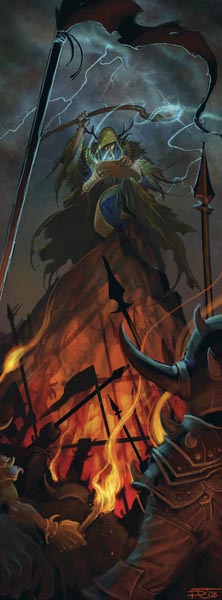
![]() One of the quickest and simplest tactical things you can do to create more engaging encounters is vary the starting distance between the party and the monsters. Too often encounter distance – and by extension, all the additional tactical options the party and monsters may have, especially early on in a fight – goes overlooked.
One of the quickest and simplest tactical things you can do to create more engaging encounters is vary the starting distance between the party and the monsters. Too often encounter distance – and by extension, all the additional tactical options the party and monsters may have, especially early on in a fight – goes overlooked.
While it may seem easier (and ultimately more dramatic or challenging) to just plop the PCs down in the center of the map or tiles every time, remember that a more immersive and believable D&D game needs some variation in encounter start locations and distance.
Starting Distance
Extrapolating from the information in the DMG, here’s generally what I use for typical starting encounter distances:
- Dungeon: 0-20 squares
- Outdoor with significant terrain or reduced visibility: 5 squares
- Outdoor, typical: 10 squares
- Outdoor, very clear or open: 20 squares
These guidelines tend to work well, creating a good and believable mix of encounter starting locations. Obviously, dungeon environments can vary greatly, especially with walls and illumination or vision (normal, low light and darkvision) alone typically having a huge impact on encounter start distance, not to mention more fantastic effects or phenomena. Still, let outdoor terrain, elements (weather), and illumination serve as a sort of three-degree reference point for your dungeon-based starting encounter distances.
Advantages
Variety of tactical play is a simple but important advantage here. Specifically, long distance start encounters mean a greater opportunity to maneuver into more defensible or advantageous positions on the battlefield. Now, both monsters and the party can move behind a few boulders or trees, or otherwise find some cover or bottleneck they particularly like. With the premium placed on mobility in 4e, characters and monsters with abilities or magic items that increase their movement or help overcome difficult terrain get to shine early on as they move into better position. Spot the Path, anyone?
Additionally, backup ranged weapons suddenly have more value as more melee-oriented characters spend time and rounds bearing down on the enemy. Long range weapons like bows and crossbows, for both PCs and monsters, become a real option, at least for a round or two. And of course, long-range spellcasters and artillery on either side actual get a chance to measure out and test the limits of those Ranged 20 powers; even powers within 10 squares suddenly require at least a round of movement and tactical positioning. There’s a reason archers have always had such an advantage at the start of battles throughout human history, and here’s one way to emulate this classic battlefield advantage.
From an encounter design level, greater starting encounter distance also helps inspire a greater number of tactical phases, features or challenges in an encounter. For example, why have those tanarukk demon orcs simply fire their crossbows from 100′ out behind a few boulders, when they can still do it from 150′ out from arrow slits in a ruined tower just behind those boulders? Now you’ve introduced and highlighted the value and threat of true artillery, combined with its most tactically advantageous terrain: superior cover.
This creates a special challenge for the party to deal with, even while a forward force of tanarukk warriors close in on them from around the blasted rocklands, using boulder cover and possibly a few crossbow shots of their own to harass the heroes as they go. A couple of very different threats like these always helps a combat encounter come alive, giving the heroes meaningful choices as far what enemies to concentrate on and how best – and who best – to deal with them.
Combat Duration and Starting Distance
The only drawback to using greater starting distances in 4e encounters is that they might add more time from maneuvering into the already overlong 60-minute average combat duration – a duration often blown away by truly challenging or adventure/play tier finale encounters. If this doesn’t bother you or your playgroup however, then go for it – vary up encounter start distance and use longer starting distances often.
Otherwise, one balanced solution is to use large starting distances in minion-only or minion-heavy encounters. This balances the extra time costs of closing and multiple rounds of artillery fire early on with threats that are more quickly eliminated once successfully attacked. Even a solo encounter with a heavy dose of global encounter elements, engaging terrain features and a host of minions fits the bill. Plus the dramatic build up of a few extra rounds of maneuvering in this sort of ultimate fight only fuels the excitement of such a momentous encounter.
Further Reading
- Global Encounter Elements
- The Art of the Backup Weapon
- Combat Mastery: Tactical Awareness & Teamwork 101
[…] Encounter Start: Distance Matters […]
[…] of Tactical Mastery by Kilsek on February 14, 2012You may have read a bit about positioning in Encounter Start: Distance Matters, but now I’m here to break down one simple […]
[…] even more at Leonine Roar: Encounter Start: Distance Matters, Initiative: Role Matters and Strikers: Assassins vs. […]